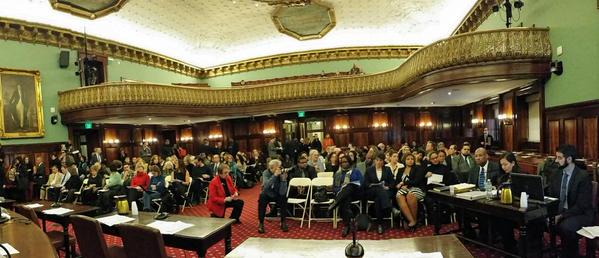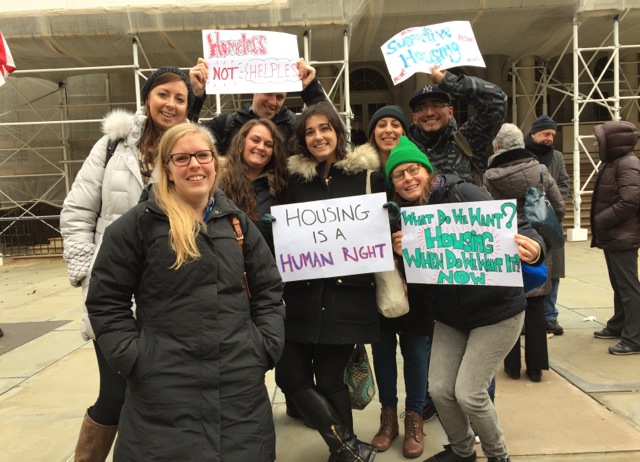In Support of Council Efforts to Diversify City Schools

Council Chambers during Thursday's packed hearing (photo: @MarkLevineNYC)
There is no more important factor than classroom diversity to assure quality education and a just society for our children. I commend the New York City Council for its courage in addressing this issue since we know that actions to correct segregation are almost as painful and politically dangerous as a failure to act.
Recently, I have discussed the need to adjust the Department of Education's policies around the placement of so-called "over-the-counter" students; single-test admissions to the city's elite high schools; and the school choice system.
On Thursday, I testified at the City Council, expressing wholehearted support for legislation to require the DOE report each year on diversity in the city's schools (Int. 511) and calling on the DOE to officially establish diversity as a priority in admissions policies and practices (Res. 453). These are necessary steps to focus the Department of Education's attention on schools and school processes that limit diversity. Every time a selection procedure fails to provide for diversity of academic, economic, geographic, racial, linguistic, gender, and ethnic populations, the DOE should have to justify not just the reasons for disproportionate inclusion of certain groups but why others are excluded.
We know from studies of student progress that all gain from exposure to difference. Even if, in a given school, test scores go up or down, individual student scores do not decline and the humans behind those scores infinitely profit from diversity's cognitive, affective, and social benefits. If the administration is serious about reducing pressure on test scores, that will have the beneficial effect of reducing pressure on principals to pre-select high scoring students.
When we ignore the importance of diversity in the name of privilege or identity, we take a step backward in fulfilling the American promise. Current crises of racial polarization, income inequality, and sexual predation are tied to the limited opportunities and demographic isolation inherent in segregated school settings. Int. 511 and Res. 453 put the Council squarely on record promoting those goals.
In qualifying my support for the third piece of legislation at hand on Thursday (Res. 442), I note my long and vigorous involvement in the federal complaint against the current Specialized High School exam which has a clear, shameful discriminatory impact against Black and Latino students.
The test also fails to meet modern standards of merit-based admission practiced by other selective high schools and colleges nationally. The exam's single great appeal is that it sorts quickly and numerically, inducing a test centered culture mired in racial bigotry. But to my mind the answer is not to amend New York State Education Law 2590-h(1)(b), which requires the test admissions practice, but to repeal it.
Why should the State Legislature be dictating selection procedures at all, setting in stone criteria which will always be, at best, imperfect? I prefer to devolve selection procedures to the city, without this strange legislative strangle-hold established by Calandra-Hecht in 1971.
***
David C. Bloomfield is Professor of Educational Leadership at Brooklyn College and the CUNY Graduate Center.
***
Have an op-ed idea or submission for Gotham Gazette? Email editor Ben Max: This email address is being protected from spambots. You need JavaScript enabled to view it.
Renewed Supportive Housing Legislation is a Must
Staff from Goddard's Manhattan Outreach Consortium at the NY/NY Press Conference
On December 8, a press conference was held on the steps of City Hall on behalf of the Campaign 4 NY/NY Housing. Undeterred by the cold, housing advocates, politicians, and formerly homeless individuals gathered to make their voices heard and to show support while City Council Member Steve Levin introduced a resolution to urge the Mayor and Governor to sign a new NY/NY agreement that would create additional units of supportive housing over the next ten years. To date, both Mayor Bill de Blasio and Governor Andrew Cuomo have stated that they would support a NY/NY IV, but neither has taken the next step to sign an agreement.
Why do we need additional units of supportive housing?
NYC homelessness is at a record high and Goddard Riverside Community Center believes that housing is a human right. It is something that each New Yorker deserves and we must ensure access.
The number one cause of homelessness is not unemployment, it is not issues related to substance abuse, nor is it ramifications of mental health problems. The number one cause of homelessness in our city, and indeed our nation, is a lack of affordable housing.
NY/NY III, the 2005 City-State agreement that provided 9,000 units of supportive housing over ten years, expires next year. A new initiative, NY/NY IV, is necessary to ensure that the creation of supportive housing does not stop. Demand has certainly not stopped. According to the Campaign 4 NY/NY Housing, for every six New Yorkers hoping (and eligible) to get a home where he or she can have a stable place to rest, to shower, to prepare a meal for his family, only one will be granted access to that home. While this number is shamefully high, it will only continue to rise if a new agreement to build additional units of supportive housing is not signed soon.
For those more swayed by economic rather than social costs, supportive housing has been proven to be a cost saving measure at a time when city and state budgets are already tight. Homeless individuals utilize emergency services, hospitals, and the criminal justice system at higher rates than those who are not homeless. When the cost of using the shelter system is also factored in, the Campaign 4 NY/NY cites that placing an individual in supportive housing saves over $10,000 per year. By this logic, place ten people in supportive housing and save over $100,000. This model has also proven to be a sustainable one that will continue to save the city and state money as people remain housed. Of all of the clients placed into permanent housing through Goddard Riverside and the Manhattan Outreach Consortium in 2013, a remarkable 92% remain housed after one year.
As the adage goes, the measure of a society is how it treats its most vulnerable members. We've got some work to do.
***
Allison McCullough is a Program Director with Goddard Riverside Community Center's Manhattan Outreach Consortium. On Twitter: @goddardriv
***
Have an op-ed idea or submission for Gotham Gazette? Email editor Ben Max: This email address is being protected from spambots. You need JavaScript enabled to view it.
More Justice, Less Politics - In Every Borough

Mayor de Blasio, left, and Brooklyn DA Ken Thompson (photo: @BilldeBlasio)
Amidst calls for special prosecutors, public hearings, and the attorney general to take over, Brooklyn District Attorney Ken Thompson has stridently defended the prerogative of his office to call a grand jury in the police killing of Akai Gurley.
It's his "duty" as Brooklyn's "duly elected district attorney" to pursue cases of police brutality, Thompson says. And citing the Ferguson and Staten Island decisions, Congressman Hakeem Jeffries, a key Thompson ally, notes that when it comes to grand juries, "prosecutors often get their wish."
Both figures may be well-intentioned proponents of police accountability, but their statements nonetheless illustrate the core problem with the grand jury process in such cases. The outcomes often boil down to politics, not law.
A closer look at the potential jury pools in Staten Island and Brooklyn illustrates the point.
Though it's becoming more diverse, Staten Island's population remains largely white, with blacks numbering about 12%. Nearly 30% of the borough's 265,000 registered voters are Republicans. About 45% of the island's potential voters are registered Democrats, but those ranks are not dominated by progressives.
The last Democrat to carry Staten Island in the mayor's race was Ed Koch (in 1985), a conservative on law-and-order issues. And while Joe Lhota lost by a landslide in the mayor's race last fall, he did carry the island, beating de Blasio 53-44%.
Staten Island, of course, is also home to many current and retired NYPD officers. There are 3,000 active duty cops living there, and together with retirees and jury-eligible family members, they constitute a vocal bloc.
As a result, "it would be difficult to empanel a grand jury in Staten Island that is not sympathetic to cops," observes veteran city reporter Wayne Barrett. "But it certainly doesn't seem like the D.A. wanted to go to trial."
In addition, D.A. Dan Donovan called a special grand jury, which makes more demands on jurors' time. Not many working people can commit to a schedule requiring a few daytime visits per week over the course of several months.
In general, this increases the likelihood that housewives and retirees are over-represented on the final panel. We don't know the occupational status of Garner jurors, but 15 of the 23 jurors were white—and based on the composite sketch above, they were likely to be sympathetic to the police.
Donovan, a Republican, is up for reelection in 2015, and he's also been mentioned as a possible contender for Michael Grimm's congressional seat, should the latter be forced to resign due to his legal troubles. In terms of his own career, Donovan had more to lose than gain by pursuing an indictment in the Garner case.
Demographically and otherwise, there's very little similarity between New York City's smallest borough and its most populous. For starters, Brooklyn is more diverse, checking in at 36% white, 32% black, 20% Latino and 10% Asian.
There are also nearly 930,000 registered Democrats in Brooklyn, as opposed to only 115,000 Republicans. While Bill Thompson (no relation to DA Ken) carried Brooklyn in the 2009 mayoral campaign (52-45%), last year de Blasio, running as a progressive with a police reform agenda, easily beat Thompson in the primary (46-27%) before crushing Lhota, the 'get tough' law and order candidate, in the general election (78-20%).
After successfully toppling long-time incumbent Joe Hynes last year, Ken Thompson, unlike Donovan, is not facing reelection, nor is he yet a potential candidate for another office. Meanwhile, it's more likely that amidst the outrage over the Garner decision, an indictment (and possibly a conviction) in the Gurley case will help more than hurt him politically.
Such glaring differences between two neighboring jurisdictions create different scales of justice. While Thompson may be able to show that the grand jury process "works" in Brooklyn, it's just as likely to remain biased in favor of police in Staten Island.
In the name of equality under the law, and in the same city, the fairest solution is thus to implement one identical process in all major cases involving police misconduct.
***
Theodore Hamm (@HammerDaily) is chair of journalism and new media studies at St. Joseph's College in Clinton Hill, Brooklyn.
***
Have an op-ed idea or submission for Gotham Gazette? Email editor Ben Max: This email address is being protected from spambots. You need JavaScript enabled to view it.





